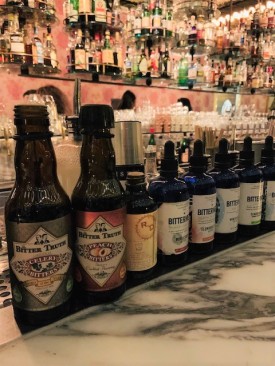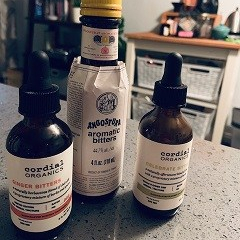I recently posted a photo on my instagram story depicting a local bar’s awesome selection of bitters, with the caption: “Sober date tip: if the bar has a beautiful collection of bitters, order a bitters and soda!” I fancied myself quite clever and adultlike with my club soda and chamomile and citrus infused bitters, but I was met with messages that ranged from a frantic “bitters have alcohol!” to an inquisitive “bitters have alcohol?” I knew that bitters do, in fact, contain alcohol, but I also knew that this amount was so negligible that I was likely to be exposed to more alcohol by drinking that mango juice that was 3 days past its expiration. However, I realized that this is not common knowledge and is in fact a pretty controversial topic in Soberland. So I decided to do a little “real” research of my own…

What are bitters? Bitters are fun little elixirs that are – yes – alcohol-based. They can be used to aid in digestion or to add complexity to cocktails (and mocktails). Seeds, spices, fruits, tree bark, roots are infused into a neutral alcohol base, creating a highly concentrated, very flavorful concoction that is then sold in small bottles. Small bottles – because they are meant to be consumed in extremely, almost ridiculously small quantities, such as a dash per drink (maybe 2).
Bitters alcohol content. Varies, but typically around 45% alcohol for classics (like Angostura). This is comparable to vanilla extract (35%) or, say, Captain Morgan. However, like vanilla. It’s a flavoring, meant to be used in very small amounts. In fact, vanilla extract is legally mandated to be atleast 35% alcohol per the FDA – anything less is labelled as imitation. So why don’t you need an ID to buy vanilla? The trick here (as with bitters), is these substances are considered “non-potable,” as in a reasonable human would not be able to tolerate/drink them in a large enough volume to actually reap the effects of their alcohol content – think mouthwash or perfume (for a fascinating history of vanilla, its high alcohol content and prohibition, check out this article). As this article puts it, “if you ever did try to drink non-potable bitters like Angostura, your tastes buds just might go on strike for a week or two.”
Alcohol content in soda + bitters. So now we know that bitters is super high in alcohol but that we are using it in tiny, tiny amounts – just a dash’ll do ya. Then how much alcohol is actually in a soda + bitters? OK so, let’s assume you use ½ tsp (or .1 oz) of 45% ABV bitters – and I am being generous here, this would be a pretty bitter-heavy drink (a quick experiment with my Cordial Organics “Celebrate” CBD Bitters showed me that their recommended dose of “1 full dropper” was just about ¼ tsp).
.45 (ABV) x 0.1 oz bitters = .45 total alcohol content
Total drink volume: 12.0 oz (soda or tonic) + 0.5 oz (melted ice) + 0.1 oz (bitters) = 12.6 ounce drink
.45 alcohol content / 12.6 oz drink = .00357
.00357 x 100 = 0.357%
So your standard bitters + soda drink = .36% ABV. And maybe you’ve notice I rounded up, because again – I am very generous.
(Here is how I did this math).
How does the alcohol content of bitters + soda measure up to other foods? In order to be labelled “non-alcoholic” in the U.S. a beverage needs to be less than 0.5% ABV – which includes your bitters & soda.
Ready for more math? This .36% ABV translates to 0.84 grams of alcohol in the total drink, or 2g/L. This is still less alcohol than is found in common fruit juices: in a study in the Journal of Analytical Toxicity (bad ass), the researchers examined the amount of ethanol content in several common foods in order to determine the average amount of alcohol that a 6 year old child could be exposed to. In this study, it was shown that grape juice contains up to 1.8 g/L of alcohol, apple juice had up to 0.66 g/L and orange juice up to 0.73g/L. So essentially, the alcohol content of your bitters drink falls just above grape juice and has about three times as much alcohol as apple or orange juice.
What about kombucha? Throwing this in here because it seems to go hand-in-hand with bitters in these types of debates. Alcohol is naturally present in kombucha due to the fermentation process, albeit in slightly higher numbers than the study above. It is also a bit harder to pin down as each brew is different due to the nature of the process. The vast majority (AKA, not Juneshine or Boochcraft) contain less than 0.5% alcohol which allows it be marketed as non-alcoholic (for reference, a standard beer contains about 4.5% – nine times as much as kombucha).
So are bitters safe in recovery? At the end of the day, a few drops of bitters in a can of bubbly water has less alcohol than a non-alcoholic beer or a kombucha and just a bit more than grape juice. But seriously – and I cannot stress this enough – it’s all about your taste, personal preference, and protecting your sobriety. Bitters are herbal, not sweet, and the alcohol could likely be detected by the most discerning of palates. For me, it doesn’t have much more effect on my taste buds than a fancy, bitter tonic water or an herbal non-alcoholic mixer, like Seedlip. If the warm, biting sting of alcohol (or even the thought of alcohol being in your drink) triggers your alcohol want-more-need-more receptors, then don’t drink bitters. It’s between you and your higher power or intuition – you are the protector of your own sobriety.

Applaud your research
LikeLiked by 1 person
Very informative!
LikeLike
Thank you for your research. I too love bitters and soda and am tired of having to defend this drink as a sober person. I will keep this article in my email to pull it up when I’m being challenged.
LikeLike
Great! And remember – it is between you and your high power/intuition. YOU know what is right for you and your sobriety.
LikeLike
Thanks.
LikeLike
thank you…very interesting.
As a recently sober person who still likes a couple dashes of bitters in club soda (with some fresh mint and ginger) I have had no problems. Of course, that is just me.
LikeLike
Haha yes you were VERY generous! There are some issues with your calc’s. Should be:
.45 (%ABV/100) x 0.1 oz bitters = .045 oz total alcohol content
.045 oz total alcohol content / 12.6 oz drink = .00357 alcohol per oz
.00357 alcohol per oz x 100 = .357% ABV
LikeLike
Hi, the math in this post has been revised and my examples have also been revised to remain accurate. Thank you for your diligence!
LikeLike
People that have an alcohol problem don’t put a tenth of an ounce of bitters in a glass of soda. Bitters are alcohol and if you are in love with your bitters and soda, it is the alcohol you are in love with. When I was first sober I always ordered bitters and soda when I went out with friends. I fell in love with it. Later when I found out about the alcohol, I realized that I was getting a slight buzz, although mild, from the bitters. You are only fooling yourself if you think otherwise. Sorry.
LikeLike
Hi Pab Lo! Thank you for your comment, no need to say “sorry.” I think what makes this article so interesting (and so very near and dear to my writer’s heart) is the myriad ways that people can read it based on their own experiences. It sounds like your experience is one which shows that if you know alcohol is in it, then it simply isn’t for you. I applaud you for the insight and protecting your own sobriety – which is all of our #1 priorities. For me, I do not get any sort of buzz from the less than 1/3 of 1 percent of alcohol in the drink, which makes sense to me because it has less alcohol than your standard Kombucha and almost the same as some fruit juices. As I noted in the article, however – it is completely up to you and your higher power (if you have one). Whatever is right for you will come through. Thank you for sharing your insights!!
LikeLiked by 1 person